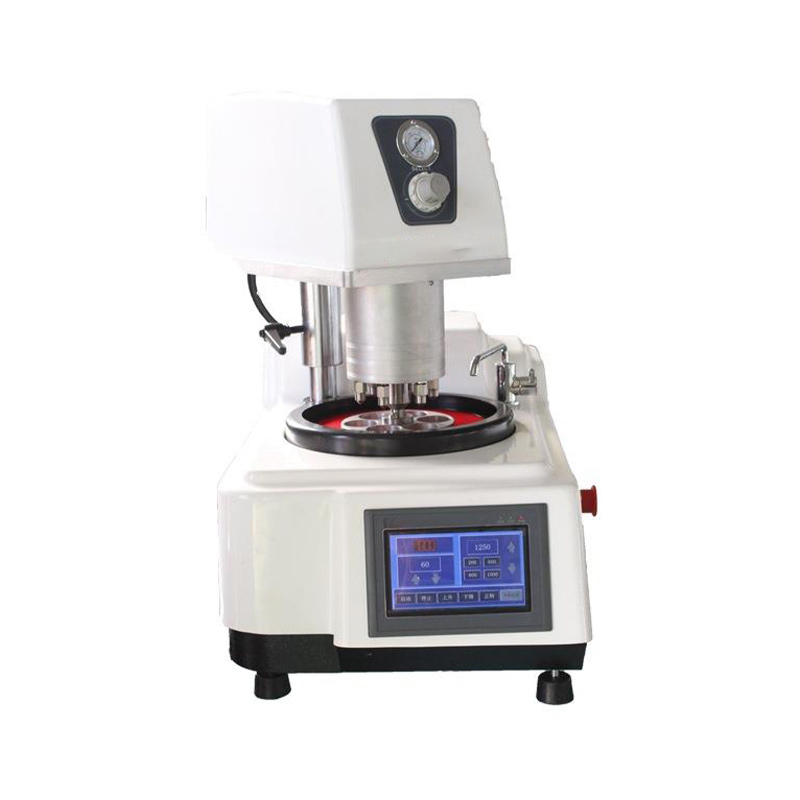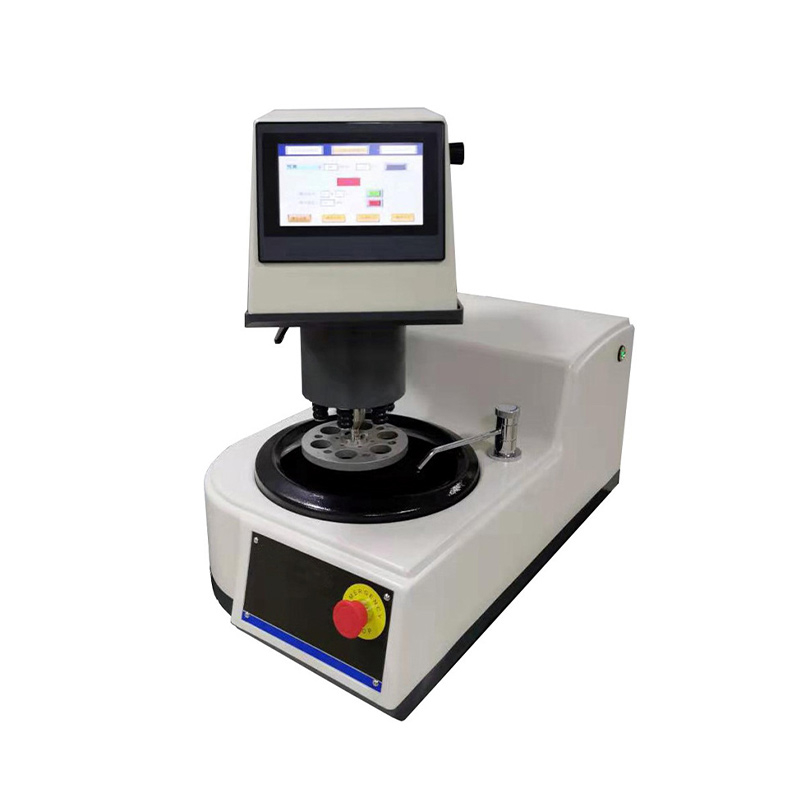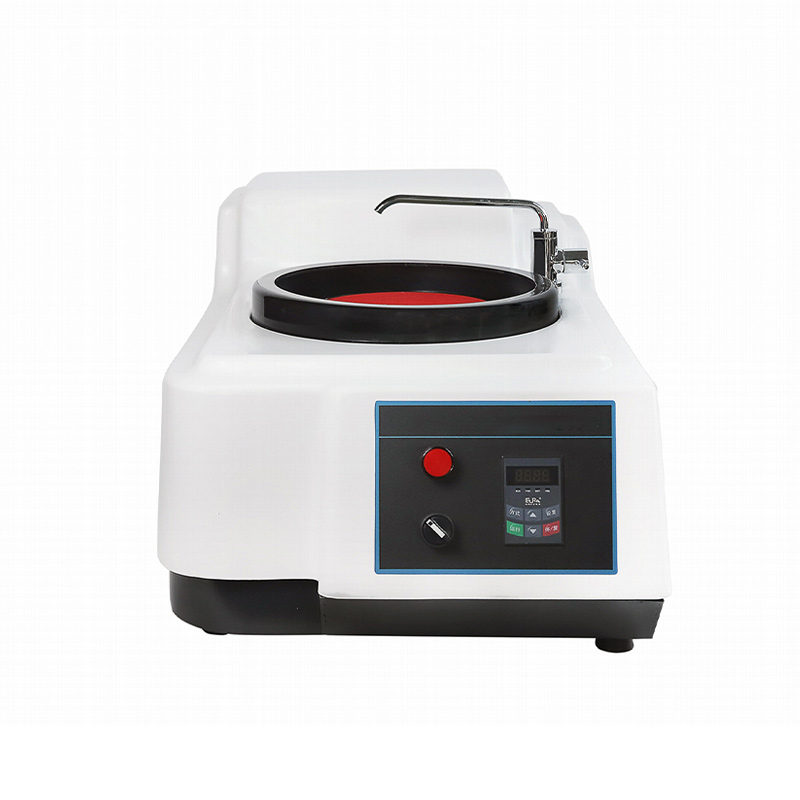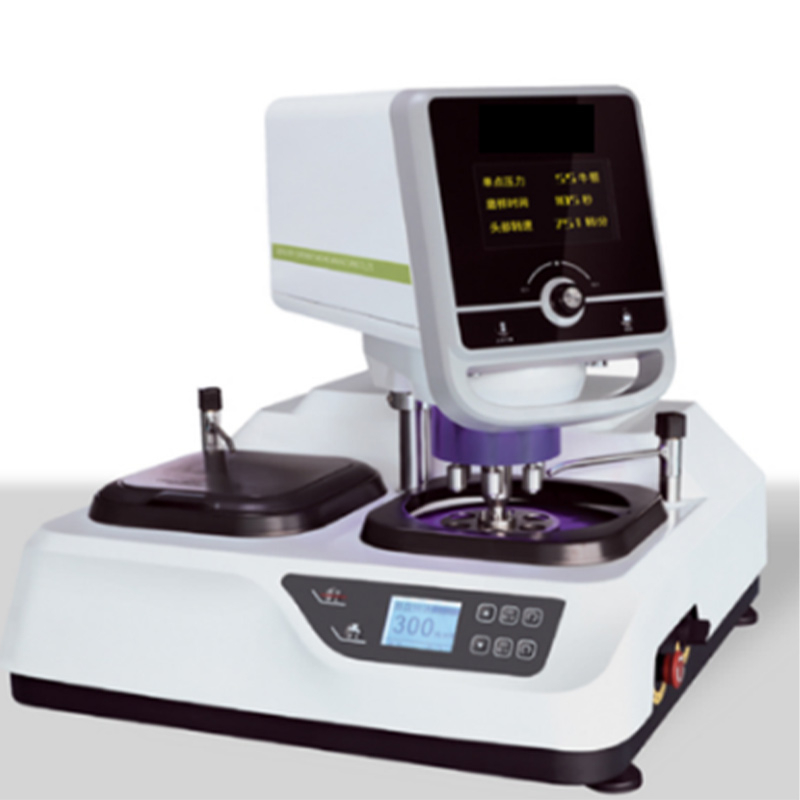Introduction
This automatic grinding and polishing machine is a single-disc desktop machine. It is a new generation of high-precision, automated sample preparation process grinding and polishing equipment manufactured according to international standards and using international advanced process technology.
This machine uses an advanced microprocessor control system, which makes the speed of the grinding and polishing disc and grinding and polishing head steplessly adjustable, and the sample preparation pressure and time settings are intuitive and convenient. The operator only needs to replace the grinding and polishing disc or metallographic sandpaper and polishing fabric to complete the grinding and polishing process, making this machine more widely applicable. This machine has the functions of arbitrary selection of the grinding and polishing disc rotation direction, quick replacement of the grinding and polishing disc; multiple sample holders and pneumatic single-point loading; automatic abrasive distribution (dispenser optional), etc. It also has the characteristics of stable rotation, safety and reliability, low noise, and the use of cast aluminum base to increase the rigidity of grinding and polishing.
This machine is equipped with a water cooling device and abrasive flushing nozzle, which can cool the sample during grinding to prevent the metallographic structure from being damaged due to overheating of the sample and flush away the abrasive at any time; it is equipped with ABS shell and stainless steel standard parts, which makes it more beautiful in appearance, improves the anti-corrosion and anti-rust performance and is easy to clean.
Application
This automatic grinding and polishing machine is suitable for automatic sample preparation in the process of rough grinding, fine grinding, rough polishing to fine polishing of metallographic samples. It is an ideal sample preparation equipment for enterprises, scientific research institutions and laboratories of colleges and universities.
Purchase information
If you are interested in our automatic grinding and polishing machine, please contact us for more information.
· Tel:138 3857 9492
· Email:carol@cysitech.com
· Contact:Carol Xu
· Wechat:15290599353
· WhatsApp/Skype: 13838579492
Technical parameters
Product name | Automatic Grinding and Polishing Machine |
Product model | CY-MP-2A |
Grinding and polishing disc | φ250mm (φ203mm, φ300mm can be customized) |
Rotating speed of polishing disc | 50~1000r/min (stepless speed regulation); 150 r/min, 300 r/min (two-stage constant speed) |
Rotating speed of polishing head | 50~150r/min (stepless speed regulation) |
Loading range | 5~60N |
Compressed air pressure | 0.6~0.9Mpa |
Sample preparation time | 0~995 S |
Sample size | φ30mm (φ22mm, φ45mm or other sizes can be customized) |
Maximum number of samples prepared each time | 4 pieces |
Working lighting | LED |
Power supply | Single-phase AC220V 50Hz |
Input power | 1.1KW |
Dimension | 594×795×687mm |
Net weight | 95kg |
Case: Application and operation of single-disc automatic grinding and polishing machine in the semiconductor industry
In the semiconductor industry, single-disc automatic grinder and polisher are usually used for wafer polishing and surface treatment to ensure the high finish and precision of the wafer surface and meet the requirements of subsequent micro-processing processes such as lithography and etching. The following is the specific operation process:
1. Preliminary preparation
Material preparation: Make sure that the wafer to be polished has been cut to the appropriate size and remove large particle contaminants on the surface. There may be slight scratches or flaws on the surface of the wafer, which need to be solved by polishing.
Equipment inspection: Check the various parameter settings of the single-disc automatic grinder and polisher, such as the speed, pressure, flow rate and temperature of the polishing disc. Ensure that the electrical and mechanical systems of the equipment are operating normally.
2. Equipment settings
Polishing disc installation: Fix the wafer on the polishing disc of the single-disk automatic grinder and polisher, usually by vacuum adsorption. Ensure that the wafer fits the polishing disc flatly to avoid deflection affecting the polishing effect.
Preparation of polishing liquid: Select the appropriate polishing liquid according to the process requirements. Common semiconductor wafer polishing liquid contains water-soluble chemical components such as hydrofluoric acid (HF) and aluminum oxide (Al2O3), which are used to remove oxide layers and tiny particles on the surface.
Speed setting: Adjust the speed of the polishing disk according to the material of the wafer and the required polishing accuracy. Generally speaking, low speed (about 20-40 rpm) is used for rough polishing, while high speed (about 50-100 rpm) is used for fine polishing.
3. Polishing process
Rough polishing stage:
Start the equipment and select a suitable polishing liquid (usually an aluminum oxide-based liquid or a silica gel suspension) to start rough polishing. The purpose of rough polishing is to remove defects and oxide layers of larger particles on the surface of the wafer to ensure a smooth surface of the wafer.
Adjust the pressure and speed to keep the wafer in moderate contact with the surface of the polishing disk. Usually, during the rough polishing process, the pressure of the polishing disk is 1-3 psi (pounds per square inch).
At this stage, the flow rate of the polishing liquid should be sufficient to ensure that the liquid can fully lubricate the wafer surface and reduce heat accumulation.
Fine polishing stage:
After the rough polishing is completed, switch to the fine polishing liquid (usually a fine-grained aluminum oxide suspension or a special chemical polishing liquid) and reduce the pressure and speed. The goal of fine polishing is to further refine the surface and make the wafer reach the desired finish.
Appropriately reduce the pressure (0.5-1 psi) and speed to remove tiny scratches and flaws on the surface and ensure a smooth and uniform surface.
4. Monitoring and adjustment
Real-time monitoring: The equipment's monitoring system tracks the surface condition of the wafer during the polishing process in real time, adjusts the polishing liquid flow, pressure, speed and other parameters to ensure that the wafer surface does not show excessive wear or uneven polishing.
Surface quality inspection: The surface finish of the wafer surface can be checked using a surface roughness meter or a microscope. If any unqualified parts are found, it is necessary to suspend polishing and adjust the process parameters.
5. Completion and post-processing
Cleaning: After polishing, use ultrapure water or an appropriate solvent to clean the wafer to remove residual polishing liquid and tiny particles to ensure that the wafer surface is clean and pollution-free.
Drying: Place the wafer in a drying device and use nitrogen or other suitable gases to blow dry the moisture on the surface of the wafer to prevent water stains and corrosion.
6. Inspection and confirmation
Final inspection: After polishing and cleaning, use a microscope or optical scanner to check the wafer surface again to ensure that there are no obvious defects and that the required surface finish is achieved.
Qualified judgment: If the surface quality of the wafer meets the requirements, it can enter the next manufacturing process; if it fails, it is necessary to re-adjust the polishing equipment or replace the polishing liquid.
Key points summary
Precision control: Semiconductor wafer polishing requires extremely high precision and uniformity. The degree of automation of the single-disk automatic grinding and polishing machine can effectively ensure the stability of the polishing process and reduce human errors.
Process adjustment: By real-time monitoring and adjustment of equipment parameters (speed, pressure, liquid flow, etc.), ensure that the surface quality of the wafer during the polishing process meets the expected standards.
Cleaning and drying: Cleaning and drying are key links in the entire process, ensuring that the wafer is free of contaminants when entering the next process and ensuring the high quality of the product.
Through the above-mentioned delicate operations, the single-disk automatic grinding and polishing machine can provide high-quality wafer surface treatment for the semiconductor industry and meet micron-level processing requirements.















